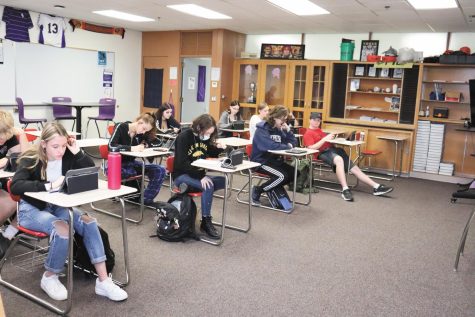East statistics compared to other schools in Metro area
Rylee Craig Co-Editor in Chief
September 30, 2022


Bellevue East’s demographics for the 2020-2021 school year, which consist of various statistics about the school, and which is published by the Nebraska Department of Education (NDE) yearly was quite different from other Metro area schools.
According to the Nebraska Department of Education (NDE), three of the biggest statistics that stood out the most were East’s per pupil expenditures, the percentage of students qualifying for free reduced lunch, and the percentage of English language learners.
The NDE State of Schools data report that per pupil expenditures is on average how much a school is spending per student, per year. This includes the total costs of instruction, administration, building operation and maintenance, plus 3 % of the value of buildings and building contents, divided by Average Daily Membership (ADM), which is the amount of students in the school or district.
East’s per pupil expenditure for the 2020-2021 school year was $14,198. Assistant Principal Nathaniel Bacon said that this number covers everything for students down to iPads, food, and basic school supplies that students might need. It also covers curriculum, and even the programs for students at the Frank Kumor Career Center.
“It is kind of all thrown into one and basically they take that budget of anything that can be used for students and divide that out based on how many students are in the district or school. Other schools might spend more or less based on students’ needs and the amount of students,” Bacon said.
According to the NDE, East is spending even more money per pupil than most other schools in the Metro area. It is even almost $1,000 per pupil more than Bellevue West, as well as almost $4,000 more than some wealthier schools like Millard West and Papillion La Vista South. Which would seem strange, considering most people would think those schools would have a higher number for per pupil expenses compared to East.
Bacon said that some schools will get more money for per pupil expenses depending on if their tax rate is higher. Even though East’s tax rate is one of the lower ones, different fundings and grants that East receives increase the supposed cost per pupil.
“We also get military impact aid and we also get some grants that other schools and districts don’t get, so they all kind of tie in as well, but it can get a little confusing to follow,” Bacon said.
Another demographic that the NDE records is different schools and districts classifications. School classification is recorded based on multiple measures of student success, including graduation rates, progress for English learners, reduction in chronic absenteeism, and other measures of school quality and student success.
It is broken down to four categories, of either excellent, great, good, and needs improvement. Classification is one way that Nebraska provides information about how each school and district is serving its students. East’s current school classification is “good.”
Bacon said, however, that East tries not to focus so much on our classification, but instead focuses on the growth of students. He said instead of comparing ourselves to other schools who have a higher classification, the administration instead looks at similar schools in both demographics and data to figure out if East students are achieving as much as they should, or if not, what can be done to change that.
“It is hard to compare us to schools like Millard West or whoever it may be, but we just look at schools who have similar demographics to us instead of like Millard West who should probably be achieving more than us because they have double our population,” Bacon said.
Even though East does not focus much on the school’s classification, some of the data that makes up this classification compared to other schools does not seem very fair. As said previously, one of these factors is the percent of English learners, which would be students whose first language is something other than English.
The NDE said that East’s percentage of English language learners (ELL) in the building is 2% of all students. Compared to other schools who have a higher classification like Millard West who is ranked as “excellent,” and Papio South who is “great,” according to their data they have less than ten students in the building who are English language learners.
If school classification is based on multiple factors of student success, one of them being the progress of English learners, then how does it seem fair if other schools only have a few students representing this data compared to schools who have way more. Even though East chooses not to focus so much on this, it still does not seem to be a level playing field.
Another statistic that the NDE records is the amount of students who qualify for free/reduced lunch. For East it is 45% of students, and compared to past years that number keeps increasing.
“I think because of the pandemic, that probably has something to do with that number increasing. With people losing their jobs and just income changing. That has just affected a lot of families that maybe weren’t in that situation before, but now have become lower income,” Social worker Susie Jones said.
Some might assume that because East, and other schools who have a high number of free/reduced lunch students, seem not as successful or as good of schools, compared to like Millard and Papillion schools who have less than 20% of students who qualify for this and ultimately have less students with financial barriers.
“I think families that find themselves with these barriers just have to be willing to reach out and maybe be creative with budgets, or find other resources to help them and their students,” Jones said.
Since East has a higher percentage of students with financial barriers, there are multiple resources the district provides for these students including the BPS Mobile Food Pantry. East also provides a food and hygiene pantry in the building for any student to utilize; it is locaed in the school nurse’s office, Kala Brown. Another benefit that all students have received the past few years at East, is free lunch and breakfast, even though this year, that has come to an end.
“The last few years it was free lunch so I don’t think as many families filled out the free/reduced form anyways. So now that we have to again, I am interested to know what our numbers for the 2023 school year will be and if there will be a huge jump or not,” Jones said.






